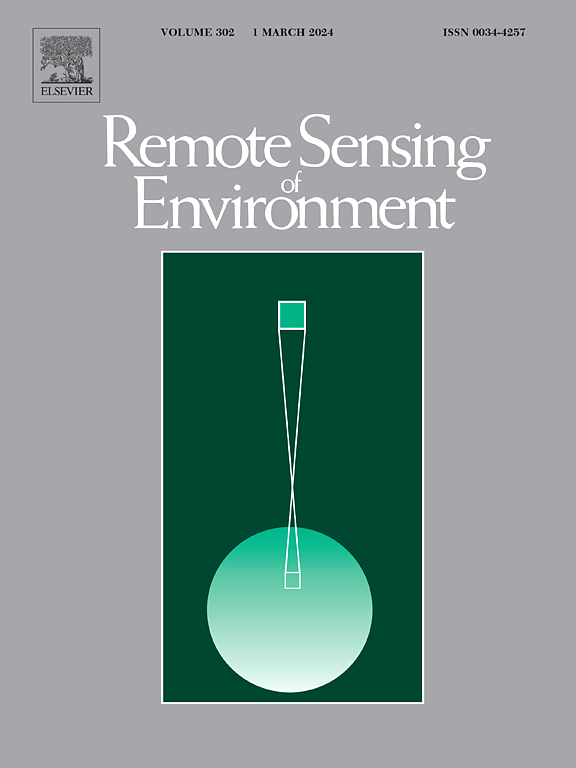在分层随机抽样设计中,地图精度对遥感数据面积估算的影响
IF 11.4
1区 地球科学
Q1 ENVIRONMENTAL SCIENCES
引用次数: 0
摘要
卫星分类地图的核心应用之一是面积估算。无论使用何种算法,地图总是会包含由不完善的输入和训练/校准数据、不完整的数据覆盖以及土地覆盖和土地利用类别之间的光谱和/或时间混淆引起的错误。由于遗漏和佣金误差,像素计数面积估计将是一个有偏估计面积估计。因此,遥感研究和应用界已经制定了解决这一问题的框架和建议做法。其中一种方法是分层随机抽样设计,在抽样设计中可以使用分类图进行分层,并从样本数据中估计区域,这些区域代表参考数据或参考类别标签。因此,地图的质量,即生产者的(PA)和用户的精度(UA),不会影响估计器的偏差,因为偏差取决于抽样设计和估计器的选择。然而,地图质量将影响分层的效率:更准确的地图将需要更小的样本量来达到估计的目标方差,或者如果样本量固定,它将产生更高的精度。本研究旨在定量评估在分层随机抽样设计中地图精度对面积估计的影响。像素计数估计器的相对偏差用类别特定的PA和UA表示,并显示为paa−1。此外,对于二元分类,混淆矩阵的元素以及样本量、面积估计器的方差和分层的相对效率(两种抽样方法的方差和样本量的乘积之比)使用PA和UA表示。数值模拟演示了相对效率如何取决于区域估计目标、目标区域比例和地图的性能度量(PA和UA)。这种依赖是非线性的,这些参数的影响是变化的。例如,当目标类是次要的或罕见的(即,它的真实比例为<;<0.5), PA的影响大于UA。随着目标面积比例的增加,精度的影响逐渐收敛,UA对效率的影响大于PA。在PA/UA空间中存在多个值,尽管受到约束,但要达到相同的目标,例如,在相对效率、样本大小和目标方差方面。总的来说,本研究为地图制作者提供了一个标准,当面积估计是分类地图的主要目标时,可以用来衡量地图生成算法的性能。本文章由计算机程序翻译,如有差异,请以英文原文为准。
The impact of map accuracy on area estimation with remotely sensed data within the stratified random sampling design
One of the core applications of satellite-based classification maps is area estimation. Regardless of the algorithms used, maps will always contain errors stemming from imperfect input and training/calibration data, incomplete data coverage, and spectral and/or temporal confusion between land cover and land use classes. Because of omission and commission errors, the pixel-counting area estimator will be a biased estimator for area estimation. Therefore, the remote sensing research and application communities have developed a framework and recommended practices to address this problem. One such approach is a stratified random sampling design, in which classification maps could be used for stratification in the sampling design, and areas are estimated from the sample data, which represent reference data or reference class labels. As such, the quality of the map, i.e., producer's (PA) and user's accuracy (UA), will not affect the bias of the estimator, as the bias depends on the sampling design and the choice of estimator. However, map quality will impact the efficiency of stratification: a more accurate map will require a smaller sample size to reach the target variance of the estimate, or it will yield improved precision if the sample size is fixed. This study aims to provide a quantitative assessment of the impact of map accuracies on area estimation within the stratified random sampling design. The relative bias of the pixel-counting estimator is expressed using class-specific PA and UA, and shown to be . Furthermore, for the case of binary classification, elements of the confusion matrix, as well as the sample size, variance of the area estimator, and relative efficiency of stratification (the ratio of the products of variance and sample size for the two sampling approaches) are expressed using PA and UA. Numerical simulations demonstrate how relative efficiency depends on area estimation objectives, target area proportion, and the map's performance metrics (PA and UA). Such dependence is nonlinear, and the impact of those parameters varies. For example, when the target class is minor or rare (i.e., its true proportion is <<0.5), the impact of PA outweighs that of UA. As the target area proportion increases, the impact of accuracies converges, and UA has a greater impact on efficiency than PA. There are multiple values in the PA/UA space, though constrained, to reach the same objectives, e.g., in terms of relative efficiency, sample size, and target variance. Overall, this study offers map producers a criterion that can be used to benchmark algorithm performance for map generation when area estimation is the primary objective of the classification maps.
求助全文
通过发布文献求助,成功后即可免费获取论文全文。
去求助
来源期刊

Remote Sensing of Environment
环境科学-成像科学与照相技术
CiteScore
25.10
自引率
8.90%
发文量
455
审稿时长
53 days
期刊介绍:
Remote Sensing of Environment (RSE) serves the Earth observation community by disseminating results on the theory, science, applications, and technology that contribute to advancing the field of remote sensing. With a thoroughly interdisciplinary approach, RSE encompasses terrestrial, oceanic, and atmospheric sensing.
The journal emphasizes biophysical and quantitative approaches to remote sensing at local to global scales, covering a diverse range of applications and techniques.
RSE serves as a vital platform for the exchange of knowledge and advancements in the dynamic field of remote sensing.
 求助内容:
求助内容: 应助结果提醒方式:
应助结果提醒方式:


